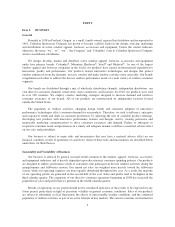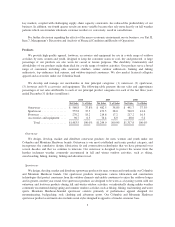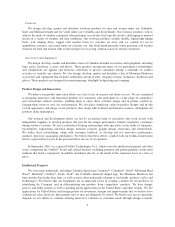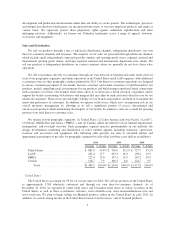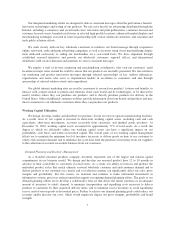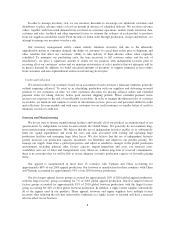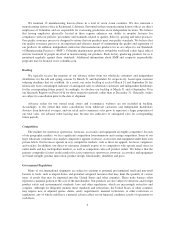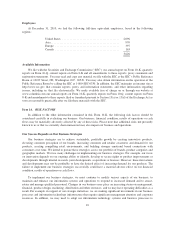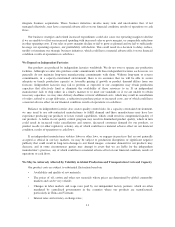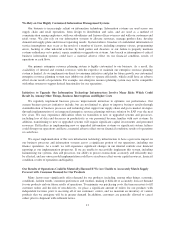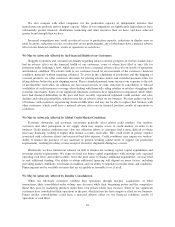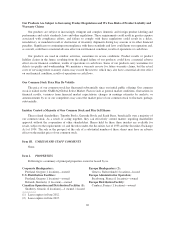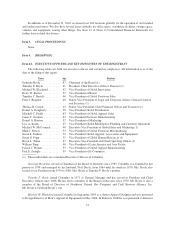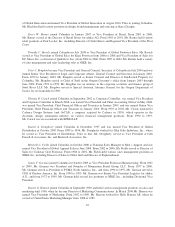Columbia Sportswear 2010 Annual Report Download - page 18
Download and view the complete annual report
Please find page 18 of the 2010 Columbia Sportswear annual report below. You can navigate through the pages in the report by either clicking on the pages listed below, or by using the keyword search tool below to find specific information within the annual report.• Availability of skilled labor and production capacity at independent factories; and
• General economic conditions.
Following a long period of generally stable-to-declining input costs, the apparel and footwear industry
appears to be entering what may become a prolonged period of inflationary pressure on some or all of these input
costs, resulting in increased costs to produce our products.
In addition, since the majority of our products are manufactured outside of our principal sales markets, our
products must be transported by third parties over large geographical distances. Shortages in ocean freight
capacity, airfreight capacity and volatile fuel costs can result in rapidly changing transportation costs. For
example, during 2010, shortages of sourcing and transportation capacity, combined with later-than-optimal
production of advance orders, caused us to rely more heavily on airfreight to achieve timely delivery to our
customers, resulting in significantly higher freight costs. Because we price our products in advance and the
external cost changes may be difficult to predict, we may not be able to pass all or a portion of such higher costs
on to our customers or adjust our pricing structure in a timely manner in order to remain competitive, which
could have a material adverse effect on our financial condition, results of operations or cash flows.
Our Sales and Profitability May be Adversely Affected by Increased Product Costs and
Reduced Selling Prices
The apparel industry is subject to significant pressures on pricing and input costs caused by many factors,
including intense competition, constrained sourcing capacity and related inflationary pressures, consolidation in
the retail industry, pressure from retailers to reduce the costs of products and changes in consumer demand.
These factors may cause us to experience increased costs, reduce our sales prices to retailers and consumers or
experience reduced sales in response to increased prices, any of which could cause our operating margin to
decline if we are unable to offset these factors with reductions in operating costs and could have a material
adverse effect on our financial condition, results of operations or cash flows.
Attracting superior retail channel partners and improving the sales productivity of our customers each
depend on various factors, including the strength of our brand names, our ability to design and source innovative
products, competitive conditions, the availability of desirable locations and the negotiation of terms with
customers. Future terms with customers may be less favorable to us than those under which we now operate.
Large wholesale customers in particular increasingly seek to transfer various costs of business to their vendors,
such as the cost of lost profits from promotional activity and product price markdowns, which could cause our
gross margins to decline if we are unable to offset price reductions with comparable reductions in operating
costs.
We May be Adversely Affected by Volatile Economic Conditions
We are a consumer products company and are highly dependent on consumer discretionary spending
patterns and the purchasing patterns of our wholesale customers as they attempt to match their seasonal purchase
volumes to volatile consumer demand. In addition, as we have expanded our base of retail stores, we have
increased our direct exposure to the risks associated with volatile and unpredictable consumer discretionary
spending patterns. As global economic conditions continue to be volatile or economic uncertainty remains, trends
in consumer discretionary spending also become unpredictable and subject to reductions due to uncertainties
about the future and credit constraints. Consumer demand for our products may not reach our sales targets, or
may decline, when there is an economic downturn or economic uncertainty in our key markets, particularly
markets in North America and our EMEA region. Our sensitivity to economic cycles and any related fluctuation
in consumer demand may have a material adverse effect on our financial condition, results of operations or cash
flows.
12


